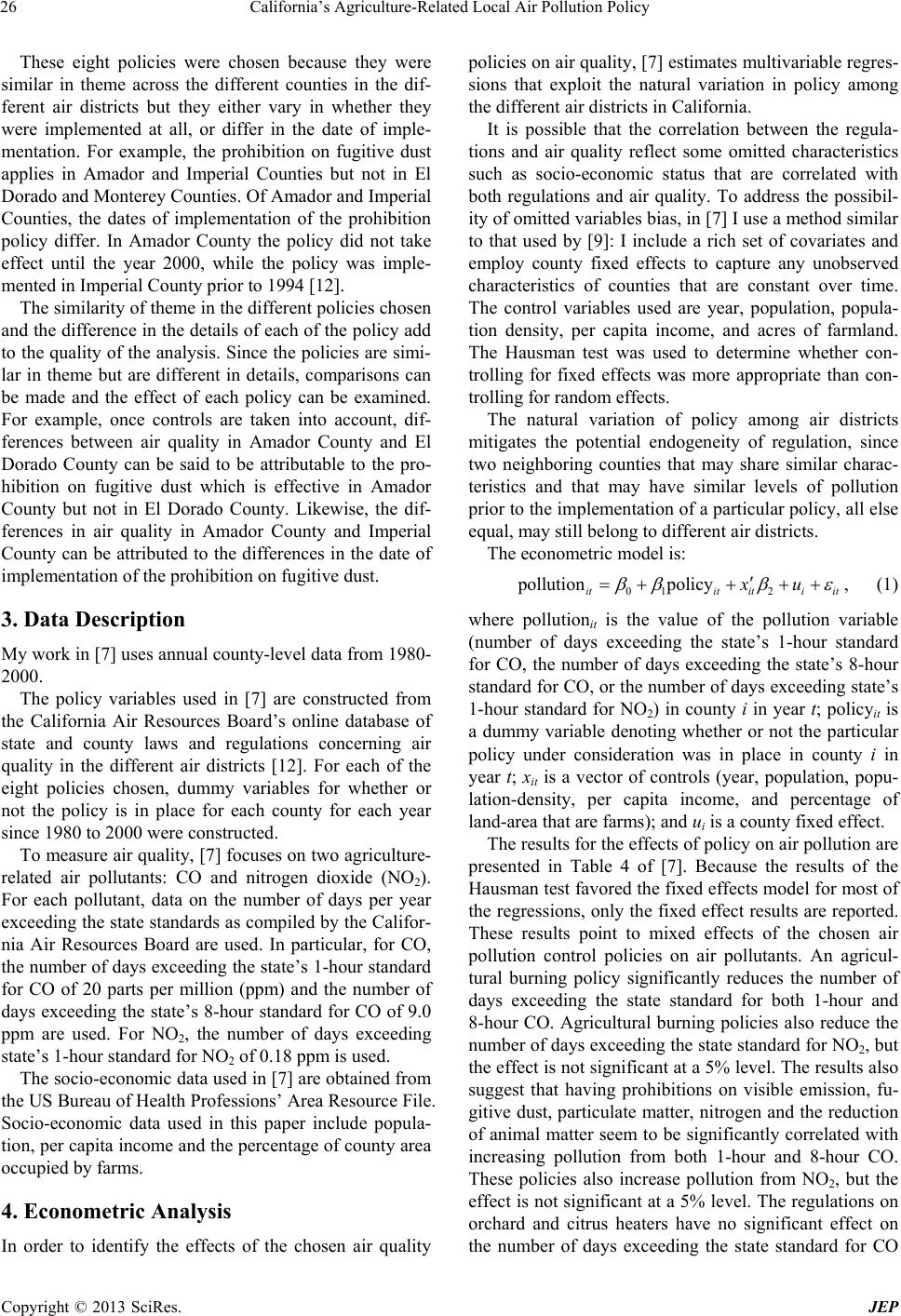
California’s Agriculture-Related Local Air Pollution Policy
26
These eight policies were chosen because they were
similar in theme across the different counties in the dif-
ferent air districts but they either vary in whether they
were implemented at all, or differ in the date of imple-
mentation. For example, the prohibition on fugitive dust
applies in Amador and Imperial Counties but not in El
Dorado and Monterey Counties. Of Amador and Imperial
Counties, the dates of implementation of the prohibition
policy differ. In Amador County the policy did not take
effect until the year 2000, while the policy was imple-
mented in Imperial County prio r to 1994 [12].
The similarity of theme in the different policies chosen
and the difference in the details of each of the policy add
to the quality of th e analysis. Since the policies are simi-
lar in theme but are different in details, comparisons can
be made and the effect of each policy can be examined.
For example, once controls are taken into account, dif-
ferences between air quality in Amador County and El
Dorado County can be said to be attributable to the pro-
hibition on fugitive dust which is effective in Amador
County but not in El Dorado County. Likewise, the dif-
ferences in air quality in Amador County and Imperial
County can be attributed to the differences in the date of
implementation of the prohibition on fugitive dust.
3. Data Description
My work in [7] uses annual county-level data from 1980-
2000.
The policy variables used in [7] are constructed from
the California Air Resources Board’s online database of
state and county laws and regulations concerning air
quality in the different air districts [12]. For each of the
eight policies chosen, dummy variables for whether or
not the policy is in place for each county for each year
since 1980 to 2000 were constructed.
To measure air quality, [7] focuses on two agricu lture-
related air pollutants: CO and nitrogen dioxide (NO2).
For each pollutant, data on the number of days per year
exceeding the state standards as compiled by the Califor-
nia Air Resources Board are used. In particular, for CO,
the number of days exceeding the state’s 1-hour standard
for CO of 20 parts per million (ppm) and the number of
days exceeding the state’s 8-hour standard for CO of 9.0
ppm are used. For NO2, the number of days exceeding
state’s 1-hour stand ard for NO2 of 0.18 ppm is used.
The socio-economic data used in [7] are obtained from
the US Bureau of Health Professions’ Area Resource File.
Socio-economic data used in this paper include popula-
tion, per capita income and the percentage of county area
occupied by farms.
4. Econometric Analysis
In order to identify the effects of the chosen air quality
policies on air q uality, [7] estimates multivariable regr es-
sions that exploit the natural variation in policy among
the different air districts in California.
It is possible that the correlation between the regula-
tions and air quality reflect some omitted characteristics
such as socio-economic status that are correlated with
both regulations and air quality. To address the possibil-
ity of omitted variab les b ias, in [7 ] I u se a method similar
to that used by [9]: I include a rich set of covariates and
employ county fixed effects to capture any unobserved
characteristics of counties that are constant over time.
The control variables used are year, population, popula-
tion density, per capita income, and acres of farmland.
The Hausman test was used to determine whether con-
trolling for fixed effects was more appropriate than con-
trolling for rando m effects.
The natural variation of policy among air districts
mitigates the potential endogeneity of regulation, since
two neighboring counties that may share similar charac-
teristics and that may have similar levels of pollution
prior to the implementation of a particular policy, all else
equal, may still belong to different air districts.
The econometric model is:
01 2
pollution policy
itititi it
xu
, (1)
where pollutionit is the value of the pollution variable
(number of days exceeding the state’s 1-hour standard
for CO, the number of days exceeding the state’s 8-hour
standard for CO, or the number of days exceeding state’s
1-hour standard for NO2) in county i in year t; policyit is
a dummy variable denoting whether or not the particular
policy under consideration was in place in county i in
year t; xit is a vector of controls (year, population, popu-
lation-density, per capita income, and percentage of
land-area that are farms); and ui is a county fixed effect.
The results for the effects of policy on air pollution are
presented in Table 4 of [7]. Because the results of the
Hausman test favored the fixed effects model for most of
the regressions, only the fixed effect results are reported.
These results point to mixed effects of the chosen air
pollution control policies on air pollutants. An agricul-
tural burning policy significantly reduces the number of
days exceeding the state standard for both 1-hour and
8-hour CO. Agricultural burning policies also reduce the
number of days exceeding the state standard for NO2, but
the effect is not significant at a 5% level. The results also
suggest that having prohibitions on visible emission, fu-
gitive dust, particulate matter, nitrogen and the reduction
of animal matter seem to be significantly correlated with
increasing pollution from both 1-hour and 8-hour CO.
These policies also increase pollution from NO2, but the
effect is not significant at a 5% level. The regulations on
orchard and citrus heaters have no significant effect on
the number of days exceeding the state standard for CO
Copyright © 2013 SciRes. JEP